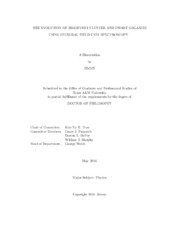| dc.description.abstract | The study of galaxy formation and evolution utilizes empirical scaling relations as a tool to better understand complex physical processes that occur below the resolution of observations. New observations of galaxy populations can provide tests of the range of validity for known scaling relations. We test the following scaling relations using IFU spectroscopy of galaxies at opposite ends of the stellar-mass spectrum.
Brightest cluster galaxies undergo, on average, more mergers than a typical early-type galaxy. They also lie at the center of their host cluster’s gravitational potential well, meaning there is no preferred alignment for mergers. As such, we would expect to find that BCGs should have preferentially lower angular momentum when compared to a population of early-type galaxies. We have spatially mapped the kinematic properties of 10 nearby brightest cluster galaxies (BCGs) in the mass range 10^10.5M ⊙ < Mdyn < 10^11.9M ⊙. We find that 30% (3/10) of the BCGs are fast rotators as defined by the ATLAS^3D criteria. This is significantly lower than the ATLAS^3D population as a whole, however our sample is biased towards higher dynamical-mass galaxies. When controlling for dynamical-mass, we find that above Mdyn ∼ 10^11.5M ⊙, both samples show the same ratio of slow rotators. This suggests that the relation be-tween galaxy angular momentum and dynamical mass is independent of the number of mergers a galaxy has undergone.
Dwarf irregular galaxies are the local universe analogs of the young high-redshift galaxies that eventually merge to form BCGs. The mass-metallicity scaling relation (MZR) says that galaxies with higher stellar-mass have preferentially higher gas metallicity. Mergers have been suggested as a potential cause of the scatter in the mass-metallicity relation as pristine gas is driven into a galaxy, diluting the metal content. Two different three-dimensional extensions of MZR, as a function of either HI-gas mass (FMRHI) or star formation rate (FMRSFR), have been suggested to account for the scatter in the MZR. We use our IFU data to study the FMRSFR and FMRHI across the stellar mass range 10^6.6 to 10^8.8 M ⊙. The lowest 1σ scatter of binned means is for the FMRHI (0.01 dex), significantly lower than that of the MZR (0.05 dex). This leads us to conclude that inflows of pristine HI-gas is the best candidate for a physically motivated fundamental metallicity relation.
Using the same sample of dwarf irregular galaxies, we investigate the relationship between Hα luminosity surface density (ΣHα) and Balmer optical depth (τb) using the added spatial information provided by IFU spectroscopy. We find a positive correlation between ΣHα and τb in 8 of 11 galaxies. Our spaxels have physical scales ranging from 30 to 80 pc, demonstrating that the correlation between these two variables continues to hold down to spatial scales as low as 30 pc. The positive correlation between ΣHα and τb is consistent even within the lowest mass galaxies.
Although brightest cluster galaxies are often considered special populations, we find that they are generally consistent with scaling relations derived for intermediate-mass early-type galaxies. Similarly dwarf irregular galaxies that span a stellar mass range 10^6.6−10^8.8 M ⊙are consistent with the mass-metallicity relation derived for star forming galaxies in the stellar mass range 10^8 – 10^11M ⊙. From this we can conclude that these scaling relations are based on fundamental physics that act across an extraordinary range of galaxy mass scales. | en |


